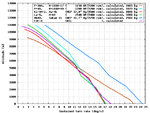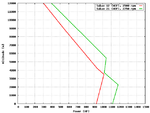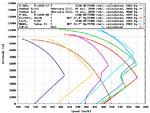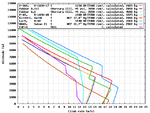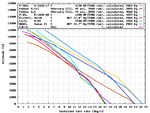Navigation
Install the app
How to install the app on iOS
Follow along with the video below to see how to install our site as a web app on your home screen.
Note: This feature may not be available in some browsers.
More options
You are using an out of date browser. It may not display this or other websites correctly.
You should upgrade or use an alternative browser.
You should upgrade or use an alternative browser.
Best radial fighter of '42 (1 Viewer)
- Thread starter Vincenzo
- Start date
Ad: This forum contains affiliate links to products on Amazon and eBay. More information in Terms and rules
More options
Who Replied?Hello HoHun
From Green's and Swnborough's Japanese Army Fighters Part 2, p. 41 "…when, pitted against all types of Army and navy fighters in firing contents at the Akeno Flying School, the Shoki invariably scored the highest points."
And both the above mentioned booklet and Francillion's Japanese A/c mentioned that already the JAAF HQ design requirements demanded that the new fighter should be a good gun platform . The wing design, substantial side area and the putting of the horizontal tail surfaces well forward all originated from that requirement.
Juha
From Green's and Swnborough's Japanese Army Fighters Part 2, p. 41 "…when, pitted against all types of Army and navy fighters in firing contents at the Akeno Flying School, the Shoki invariably scored the highest points."
And both the above mentioned booklet and Francillion's Japanese A/c mentioned that already the JAAF HQ design requirements demanded that the new fighter should be a good gun platform . The wing design, substantial side area and the putting of the horizontal tail surfaces well forward all originated from that requirement.
Juha
Hello HoHun,
From the P-40 threads, your graph of the A6M2-21 put its maximum speed with WEP at 328 mph. Your graph here puts a A6M3 Model 22 or 32 at 357 mph. Clipped wings or not, the airframes of all three aircraft are VERY similar, so I am curious as to what your engine power / altitude graph looks like. Keep in mind that the A6M5 with ejector stacks would be even faster than either version of A6M3.
The P-43 by numbers sounds like a pretty good aircraft, but in service in China, it had so many faults as to be useless. These planes were generally unserviceable from what I have read about the type.
The F4F-4 really should not be here. Instead, replace it with the F4F-3 which has better armament (duration) and much better performance.
I have seen "in service" dates for the F4U Corsair as December 1942. If that is accurate, it would certainly be a contender.
FWIW, my vote goes to the FW 190A. Nothing else (except the Corsair) had anywhere near the same speed and few of the other aircraft had close the same climb rate. I believe that for 1942, the FW 190A is the best fighter regardless of engine type.
- Ivan.
From the P-40 threads, your graph of the A6M2-21 put its maximum speed with WEP at 328 mph. Your graph here puts a A6M3 Model 22 or 32 at 357 mph. Clipped wings or not, the airframes of all three aircraft are VERY similar, so I am curious as to what your engine power / altitude graph looks like. Keep in mind that the A6M5 with ejector stacks would be even faster than either version of A6M3.
The P-43 by numbers sounds like a pretty good aircraft, but in service in China, it had so many faults as to be useless. These planes were generally unserviceable from what I have read about the type.
The F4F-4 really should not be here. Instead, replace it with the F4F-3 which has better armament (duration) and much better performance.
I have seen "in service" dates for the F4U Corsair as December 1942. If that is accurate, it would certainly be a contender.
FWIW, my vote goes to the FW 190A. Nothing else (except the Corsair) had anywhere near the same speed and few of the other aircraft had close the same climb rate. I believe that for 1942, the FW 190A is the best fighter regardless of engine type.
- Ivan.
claidemore
Senior Airman
Thought I would give a plug for the Ki43 Haybusa.
The 2nd model with two 12.7mm machine guns came out in November of 42, so fits the bill for this discussion.
Fighter vs Fighter, this little plane was plenty dangerous, it's dogfighting ability probably superior even to the Zero. Not as fast as some of the others, in dive or level speed, but it climbed better than most, if not all the radial engined fighters of 1942.
I'm not saying it was the best in 1942, but the Oscar definately was a serious opponent and deserves at least an honorable mention if not serious consideration.
Besides, I like it!
The 2nd model with two 12.7mm machine guns came out in November of 42, so fits the bill for this discussion.
Fighter vs Fighter, this little plane was plenty dangerous, it's dogfighting ability probably superior even to the Zero. Not as fast as some of the others, in dive or level speed, but it climbed better than most, if not all the radial engined fighters of 1942.
I'm not saying it was the best in 1942, but the Oscar definately was a serious opponent and deserves at least an honorable mention if not serious consideration.
Besides, I like it!
Hi Juha,
>From Green's and Swnborough's Japanese Army Fighters Part 2, p. 41 "…when, pitted against all types of Army and navy fighters in firing contents at the Akeno Flying School, the Shoki invariably scored the highest points."
>And both the above mentioned booklet and Francillion's Japanese A/c mentioned that already the JAAF HQ design requirements demanded that the new fighter should be a good gun platform .
Thanks a lot! I've always thought the Ki-44 was a pretty good aircraft whose good qualities are usually missed because it doesn't fit into the "nimble but underpowered" stereotype of a Japanese fighter.
I've always thought the Ki-44 was a pretty good aircraft whose good qualities are usually missed because it doesn't fit into the "nimble but underpowered" stereotype of a Japanese fighter.
If you're a fan of the Ki-44 too, here some interesting comments by Mustang pilot 'Ax' Hiltgen of the 530th Fighter Squadron (from Roger Freeman's "Combat Profile: Mustang"):
"Altitude was important to get over the bad weather in combat and when we encountered 'Tonys' and 'Tojos' - particularly the latter."
"Fortunately for us, as the Japanese planes got better - with the 'Tojo' the best - their fighter pilot quality plummeted."
"As mentioned earlier, the only Japanese plane that came close to the characteristics of the P-51 was the 'Tojo'. With the 'Oscar' and 'Zero', if you stayed out of tight, slow manoeuvres and used the advantages of the Mustang you would win."
Of course, he's thinking of the better-performing Ki-44-II, not of the Ki-44-I relevant in the context of this thread, but the handling charactieristics probably didn't change much between the versions.
Regards,
Henning (HoHun)
>From Green's and Swnborough's Japanese Army Fighters Part 2, p. 41 "…when, pitted against all types of Army and navy fighters in firing contents at the Akeno Flying School, the Shoki invariably scored the highest points."
>And both the above mentioned booklet and Francillion's Japanese A/c mentioned that already the JAAF HQ design requirements demanded that the new fighter should be a good gun platform .
Thanks a lot!
If you're a fan of the Ki-44 too, here some interesting comments by Mustang pilot 'Ax' Hiltgen of the 530th Fighter Squadron (from Roger Freeman's "Combat Profile: Mustang"):
"Altitude was important to get over the bad weather in combat and when we encountered 'Tonys' and 'Tojos' - particularly the latter."
"Fortunately for us, as the Japanese planes got better - with the 'Tojo' the best - their fighter pilot quality plummeted."
"As mentioned earlier, the only Japanese plane that came close to the characteristics of the P-51 was the 'Tojo'. With the 'Oscar' and 'Zero', if you stayed out of tight, slow manoeuvres and used the advantages of the Mustang you would win."
Of course, he's thinking of the better-performing Ki-44-II, not of the Ki-44-I relevant in the context of this thread, but the handling charactieristics probably didn't change much between the versions.
Regards,
Henning (HoHun)
Hi Ivan,
>Clipped wings or not, the airframes of all three aircraft are VERY similar, so I am curious as to what your engine power / altitude graph looks like.
Remember that the Sakae 21 had a two-speed supercharger while the Sakae 12 had only a single-stage one, so the difference between the A6M2 and the A6M3 is a bit like the difference between the Spitfire V and the Spitfire IX.
Here are the engine graphs ...
>The P-43 by numbers sounds like a pretty good aircraft, but in service in China, it had so many faults as to be useless. These planes were generally unserviceable from what I have read about the type.
Well, they might not have had the fully equipped and trained support in China they'd have had with a regular USAAF unit.
>The F4F-4 really should not be here. Instead, replace it with the F4F-3 which has better armament (duration) and much better performance.
Hm, cosmetic change only
>I have seen "in service" dates for the F4U Corsair as December 1942. If that is accurate, it would certainly be a contender.
Vincenzo said "only fighter actually fightning in '42"
Regards,
Henning (HoHun)
>Clipped wings or not, the airframes of all three aircraft are VERY similar, so I am curious as to what your engine power / altitude graph looks like.
Remember that the Sakae 21 had a two-speed supercharger while the Sakae 12 had only a single-stage one, so the difference between the A6M2 and the A6M3 is a bit like the difference between the Spitfire V and the Spitfire IX.
Here are the engine graphs ...
>The P-43 by numbers sounds like a pretty good aircraft, but in service in China, it had so many faults as to be useless. These planes were generally unserviceable from what I have read about the type.
Well, they might not have had the fully equipped and trained support in China they'd have had with a regular USAAF unit.
>The F4F-4 really should not be here. Instead, replace it with the F4F-3 which has better armament (duration) and much better performance.
Hm, cosmetic change only
>I have seen "in service" dates for the F4U Corsair as December 1942. If that is accurate, it would certainly be a contender.
Vincenzo said "only fighter actually fightning in '42"
Regards,
Henning (HoHun)
Attachments
Hi Vincenzo,
>i add at hopeless G 50 (the M.C. 200 was superior in all aspect but easy production and ceilling, and three italian plane in same category are too, also if re 2000 was more a hungarian plane as utilization), i am not so sure that vanguard was hopeless, almost on paper, but i readed of it fragile airframe. i know a very little on IAR 80. for clear MB 152 on FARR was for in service in romania air force.
Do you have some top speed at altitude figures for these?
I added some more fighters to the diagrams ... the Fokker G.I is an extra since I don't think it was still fighting in 1942.
Regards,
Henning (HoHun)
>i add at hopeless G 50 (the M.C. 200 was superior in all aspect but easy production and ceilling, and three italian plane in same category are too, also if re 2000 was more a hungarian plane as utilization), i am not so sure that vanguard was hopeless, almost on paper, but i readed of it fragile airframe. i know a very little on IAR 80. for clear MB 152 on FARR was for in service in romania air force.
Do you have some top speed at altitude figures for these?
I added some more fighters to the diagrams ... the Fokker G.I is an extra since I don't think it was still fighting in 1942.
Regards,
Henning (HoHun)
Attachments
Hi again,
OK, so the new list:
Third Rate
P-35, P-36, F2A, I-16, A5M, Ki-37, D.XXI, Fiat G.50
Second Rate:
P-43, F4F-4 Wildcat
(P-43 had unprotected wet wings and was thus very vulnerable.)
Possible Contenders
P-66?, IAR 80?, Ki-43?, Reggiane Re.2000?, Macchi M.C.200?, MB 152 on FARR?
(Question marks denote types which I haven't had a close look at yet.)
Definite Contenders
La-5, Fw 190A-4, Ki-44-I, A6M3
Two more included in the list. The P-43 is "shot from the hip" because there is so little information on the type, everything you have would be welcome!
Regards,
Henning (HoHun)
Methinks that italian G-50/Re-2000/MC-200 should be on par with Buffalo, F-4F and I-16 (late models that do fit in our 1942 time frame), or even under those. With circa 500km/h and 2 HMGs on board, neither their performance nor armament allows for a better score. (I know what that '?' means
- Thread starter
- #50
I've from italian test of 39,
G 50 max speed 483 km/h at 4500 meters, 451 km/h at 6000 meters (at 2330 kg) (climb at 6 7'3'', at 4 4'14'')
Re 2000 max speed 518 km/h at 5250 meters, 506 km/h at 6000 meters (at 2529 kg) (climb at 6 km 6'23'', at 4 3'57'')
M.C.200 max speed 502 km/h at 5000 meters, 493 km/h at 6000 meters (at 2208 kg) (climb a7 6 km 6'29'', at 4 3'54'')
engine power for G 50 and M.C. 200 (have same engine) 840 HP at 3800 meters (it's not wep also the italian can up the hg pression the called +100 (mm of hg)), for Re 2000 1000 HP at 4000 meters.
for others from source on internet
MB 152 515 km/h at 4000 (as in '40 in france)
IAR 80A 510 km/h at 4000 (probably also less, also if some sources report more at higher quote, but i don't think that rated altitude of engine can done this)
we need add PZL P.24 to hopeless category
G 50 max speed 483 km/h at 4500 meters, 451 km/h at 6000 meters (at 2330 kg) (climb at 6 7'3'', at 4 4'14'')
Re 2000 max speed 518 km/h at 5250 meters, 506 km/h at 6000 meters (at 2529 kg) (climb at 6 km 6'23'', at 4 3'57'')
M.C.200 max speed 502 km/h at 5000 meters, 493 km/h at 6000 meters (at 2208 kg) (climb a7 6 km 6'29'', at 4 3'54'')
engine power for G 50 and M.C. 200 (have same engine) 840 HP at 3800 meters (it's not wep also the italian can up the hg pression the called +100 (mm of hg)), for Re 2000 1000 HP at 4000 meters.
for others from source on internet
MB 152 515 km/h at 4000 (as in '40 in france)
IAR 80A 510 km/h at 4000 (probably also less, also if some sources report more at higher quote, but i don't think that rated altitude of engine can done this)
we need add PZL P.24 to hopeless category
- Thread starter
- #51
found this on P-43 (the A-1 chinese variant was only used in fightning)
The Pacific War Online Encyclopedia: P-43 Lancer, U.S. Fighter
Republic P-43 Lancer
Republic P-43 Lancer fighter plane in Chinese service (Richard Dunn)
The Pacific War Online Encyclopedia: P-43 Lancer, U.S. Fighter
Republic P-43 Lancer
Republic P-43 Lancer fighter plane in Chinese service (Richard Dunn)
- Thread starter
- #52
Hi HoHun
sure too late for G.I but for true there was a twin engine fighter with radial the Beaufighter but i think it's not a match also for the 2nd categoryI added some more fighters to the diagrams ... the Fokker G.I is an extra since I don't think it was still fighting in 1942.
Hello HoHun,
Thanks for the engine power graph on the Sakae versions. I will check if the data points match what little documentation I have.
Regarding the F4F-3 versus F4F-4, the differences are FAR from cosmetic. The F4F-3 did not have folding wings or anywhere near as much armour. It was 15-20 mph faster, weighed about 500 pounds less and only had 4 MGs with more ammunition instead of 6. Best climb rate was also well over 1000 fpm faster, so it is hardly the same aircraft. Depending on your preference, there is also the F4F-3A with a slightly lower rated altitude with IIRC a R-1830-92 instead of the R-1830-76 engine. I have seen comments that the excessive supercharging of the -76 engine was not really needed out in the Pacific.
The information I saw on the P-43 was actually found while looking for data on the Curtiss-Wright CW-21B. The CW-21B never did particularly well in combat, but was quite competitive for performance and perhaps should be included here as well?
- Ivan.
Thanks for the engine power graph on the Sakae versions. I will check if the data points match what little documentation I have.
Regarding the F4F-3 versus F4F-4, the differences are FAR from cosmetic. The F4F-3 did not have folding wings or anywhere near as much armour. It was 15-20 mph faster, weighed about 500 pounds less and only had 4 MGs with more ammunition instead of 6. Best climb rate was also well over 1000 fpm faster, so it is hardly the same aircraft. Depending on your preference, there is also the F4F-3A with a slightly lower rated altitude with IIRC a R-1830-92 instead of the R-1830-76 engine. I have seen comments that the excessive supercharging of the -76 engine was not really needed out in the Pacific.
The information I saw on the P-43 was actually found while looking for data on the Curtiss-Wright CW-21B. The CW-21B never did particularly well in combat, but was quite competitive for performance and perhaps should be included here as well?
- Ivan.
Hello HoHun
And thanks for the Ki-44 comments from Freeman's book.
I have always liked also Ki-43 and even more so after learning RAF/RAAF problems with it in Burma. Dissimilar combat have always had its problems. RAF/RAAF maybe suffered more than USAAF because they needed different tactics in Asia than in Europe. USAAF principles, keep the speed up and don't be sucked in low speed horizontal or vertical combat, worked well against both Japanese and Bf 109. Maybe also USAAF succeeded better to indoctrinate its pilots to the importance of teamwork.
Experienced JAAF pilots seemed to have liked Ki-43 but of course they were forced to play defensive role and to try to lure the opponent to make mistakes.
Finns definitely thought that Brewster Model 239 was better than Fiat G.50. Judging from Finnish tests I have came to conclusion that max speed of G.50 (483km/h) was for an early plane with canopy and the latter open cockpit planes were probably a bit slower as they were more draggy.
Juha
And thanks for the Ki-44 comments from Freeman's book.
I have always liked also Ki-43 and even more so after learning RAF/RAAF problems with it in Burma. Dissimilar combat have always had its problems. RAF/RAAF maybe suffered more than USAAF because they needed different tactics in Asia than in Europe. USAAF principles, keep the speed up and don't be sucked in low speed horizontal or vertical combat, worked well against both Japanese and Bf 109. Maybe also USAAF succeeded better to indoctrinate its pilots to the importance of teamwork.
Experienced JAAF pilots seemed to have liked Ki-43 but of course they were forced to play defensive role and to try to lure the opponent to make mistakes.
Finns definitely thought that Brewster Model 239 was better than Fiat G.50. Judging from Finnish tests I have came to conclusion that max speed of G.50 (483km/h) was for an early plane with canopy and the latter open cockpit planes were probably a bit slower as they were more draggy.
Juha
- Thread starter
- #56
davparlr
Senior Master Sergeant
I haven't done detailed research, but I would say that I would climb into the cockpit of the Fw-190A-3 any day over any of the other 1942 radials. 1943 is a different story.
Lucky13
Forum Mascot
I was going to say the Swedish J22, first flew in '42. Managed to 575 Km/h with 1.065 engine and could hold its own against the P-51D's that we used in our airforce....
But then reason and common sense kicked in....and I'm not so sure!

I think that I'll have to go with the '190 here, just look what came out of it later, the Doras!
But then reason and common sense kicked in....and I'm not so sure!
I think that I'll have to go with the '190 here, just look what came out of it later, the Doras!
- Thread starter
- #60
Users who are viewing this thread
Total: 2 (members: 0, guests: 2)

